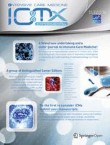Extracellular superoxide dismutase (ECSOD) protects nitric oxide (NO) bioavailability by decreasing superoxide levels and preventing peroxynitrite generation, which is important in maintaining renal blood flow...
Authors:
Larissa Constantino, Letícia Selinger Galant, Francieli Vuolo, Karla Lorena Guarido, Luiza Wilges Kist, Giovanna Medeiros Tavares de Oliveira, Matheus Augusto de Bittencourt Pasquali, Cláudio Teodoro de Souza, José Eduardo da Silva-Santos, Maurício Reis Bogo, José Cláudio Fonseca Moreira, Cristiane Ritter and Felipe Dal-Pizzol
Citation:
Intensive Care Medicine Experimental
2017
5:15
Content type: Research
Published on: 16 March 2017
